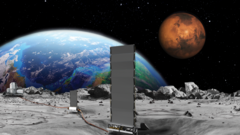NASA is accelerating its plans to establish a nuclear reactor on the lunar surface, targeting completion by 2030. This initiative is a crucial component of the United States' broader ambition to develop a sustainable human presence on the Moon, especially in light of similar objectives from countries like China and Russia. Reports from US media, including Politico, indicate caution among experts regarding the feasibility of achieving these goals, largely due to recent budget cuts to NASA and concerns over the geopolitical motivations behind the project.
US Transportation Secretary Sean Duffy, acting head of NASA appointed by President Donald Trump, emphasized the necessity of rapid advancements in nuclear technology for the Moon. He has called for proposals from private companies to design and build a reactor capable of producing at least 100 kilowatts of power. This modest power output stands in contrast to typical onshore wind turbine capabilities, which can generate 2-3 megawatts.
The concept of a lunar nuclear reactor is not without precedent. In 2022, NASA awarded $5 million contracts to multiple companies to develop reactor designs. This aligns with international efforts, as both China and Russia have announced plans for a lunar nuclear power station by 2035, acknowledging that nuclear energy may be the only practical method to ensure a consistent power supply on the Moon amidst its prolonged periods of sunlight and darkness.
Dr. Sungwoo Lim, a senior lecturer at the University of Surrey, argued for the inevitability of nuclear energy in supporting lunar habitats, as solar power alone may not be sufficient to meet the needs for large-scale habitats. Lionel Wilson, a planetary sciences professor, concurred that with the right funding, deploying these reactors by 2030 is feasible, citing existing small reactor designs.
However, concerns persist regarding the safety of launching radioactive materials into space. Dr. Simeon Barber from the Open University noted that while special licenses are required for such launches, the associated risks remain manageable. Duffy's push for rapid development is tempered by political implications, particularly after significant cuts to NASA's budget that have cast doubt on a variety of programs, including the Mars Sample Return mission.
Experts voice apprehensions that this renewed space race could prioritize national interests over collaborative scientific endeavors. Dr. Barber warned that a focus on territorial claims related to lunar operations could overshadow the broader goal of solar system exploration.
The Artemis Accords, established in 2020, exemplify the recent attempts to foster cooperation in lunar exploration among space-faring nations. These accords propose the creation of safety zones around lunar operations, raising concerns about potential territorial claims on the Moon as nations establish infrastructure.
As NASA works towards its Artemis 3 mission, which aims to land humans on the Moon by 2027, logistical uncertainties remain. The viability of nuclear power for lunar bases depends heavily on the successful delivery of personnel and resources to the Moon, highlighting the intricate challenges that lie ahead in establishing a sustainable human presence on Earth's celestial neighbor.



















